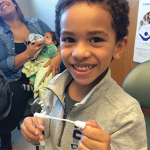On a different subject, Dr. Ruth highlighted a study from Jaeggi and colleagues that sought to answer the question: why are some, but not all, offspring of anti-Ro antibody-positive mothers affected by the cardiac manifestations (e.g., heart block and endocardial fibroelastosis) of neonatal lupus? The study looked at antibody-positive mothers referred for serial fetal cardiac assessment at ≤20 weeks’ gestation either for those a) at risk for cardiac manifestations of neonatal lupus (CNL) or b) with a new diagnosis of CNL. Maternal anti-Ro 52 and anti-Ro 60 were measured using a chemiluminescent immunoassay (CIA), and additional testing on diluted serum samples was used to quantify anti-Ro 60 antibody titers above the analytical measuring range (AMR) of the standard CIA. The authors found that among 27 mothers with a fetal diagnosis of CNL all displayed anti-Ro 60 antibody titers that exceeded the AMR of the CIA by at least 10-fold. In both the group of patients at risk for and with confirmed CNL in the fetus, there was a positive relationship between event rates of CNL and higher anti-Ro 60 titers.10
In Sum
The session covered many more topics beyond those described above and speaks to the pace at which new knowledge is being discovered across the world of pediatric rheumatology. Thanks to Dr. Turnier and Dr. Ruth, the audience was able to get a taste of the many advances being seen in this specialty, and much more is likely to come in 2025.
Jason Liebowitz, MD, is an assistant professor of medicine in the Division of Rheumatology at Columbia University Vagelos College of Physicians and Surgeons, New York.
References
- Sparks R, Rachmaninoff N, Lau WW, et al. A unified metric of human immune health. Nat Med. 2024 Sep;30(9):2461–2472.
- Cui A, Huang T, Li S, Ma A, et al. Dictionary of immune responses to cytokines at single-cell resolution. Nature. 2024 Jan;625(7994):377–384.
- Bodansky A, Mettelman RC, Sabatino JJ Jr., et al.; Overcoming COVID-19 Network Investigators. Molecular mimicry in multisystem inflammatory syndrome in children. Nature. 2024 Aug;632(8025):622–629.
- Davidson S, Shibata Y, Collard S, et al. Dominant negative OTULIN-related autoinflammatory syndrome. J Exp Med. 2024 Jun 3;221(6):e20222171.
- Oda H, Manthiram K, Chavan PP, et al. Biallelic human SHARPIN loss of function induces autoinflammation and immunodeficiency. Nat Immunol. 2024 May;25(5):764–777.
- Densen P. Challenges and opportunities facing medical education. Trans Am Clin Climatol Assoc. 2011;122:48–58.
- Brunner HI, Ruperto N, Ramanan AV, et al.; PRINTO and PRCSG Investigators. Long-term efficacy and safety of subcutaneous tocilizumab in clinical trials of polyarticular or systemic juvenile idiopathic arthritis. Rheumatology (Oxford). 2024 Sep 1;63(9):2535–2546.
- Brunner HI, Akikusa JD, Al-Abadi E, et al.; Paediatric Rheumatology International Trials Organisation (PRINTO) and Pediatric Rheumatology Collaborative Study Group (PRCSG). Safety and efficacy of tofacitinib for the treatment of patients with juvenile idiopathic arthritis: Preliminary results of an open-label, long-term extension study. Ann Rheum Dis. 2024 Oct 21;83(11):1561–1571.
- Vojinović J, Foeldvari I, Dehoorne J, et al. Ten-year safety and clinical benefit from open-label etanercept treatment in children and young adults with juvenile idiopathic arthritis. Rheumatology (Oxford). 2024 Jan 4;63(1):140–148.
- Jaeggi E, Kulasingam V, Chen J, et al. Maternal anti-Ro antibody titers obtained with commercially available immunoassays are strongly associated with immune-mediated fetal heart disease. Arthritis Rheumatol. 2023 Sep;75(9):1556–1565.

